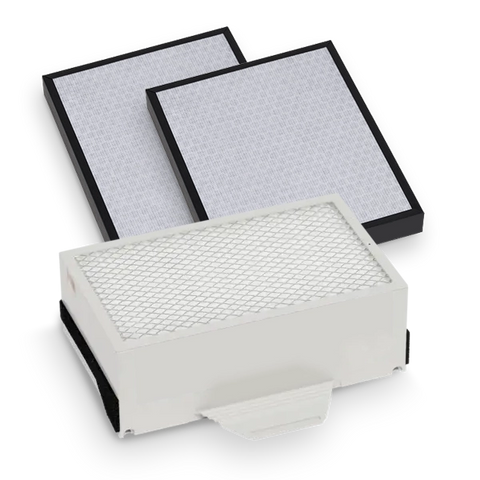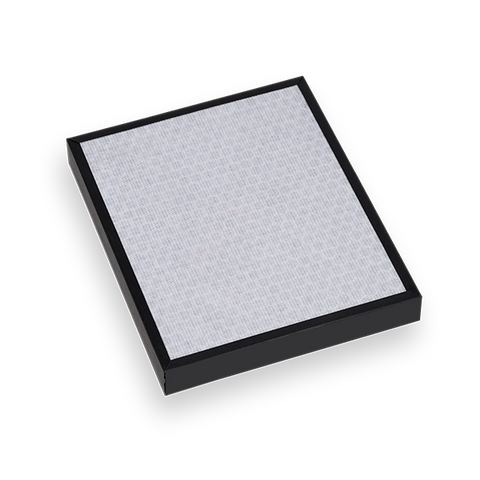Pets bring an amazing amount of joy to our lives. Whether it’s a dog, cat, ferret, fish, or other friendly companion, they’ll influence your living space. Food bowls, cozy beds, litter boxes, and bubbling water show that a well-loved pet lives here. Unfortunately, there’s another sign that a pet lives in the home: pet odors. But it doesn’t have to be that way! If you choose the right air purifier, you can keep pet odors at bay.
Filter Type Matters
A high-quality air filter is extremely important for dealing with pet smells and allergies. Pet dander crumbles into extremely small sizes, making it very difficult to capture. The Intellipure Compact meets or exceeds the HEPA standard, so it can catch even tiny pet dander. Intellipure’s Disinfecting Filtration System (DFS) technology uses electronically enhanced filtration to attract and capture ultrafine particles. It removes up to 99.97% of allergens, mold, and viruses down to 0.3 microns for superior indoor air quality. But physically filtering our pet hair and dander from the air is only part of the job.
While most air purifiers use HEPA filters, an activated carbon filter is needed to remove pet odors. Activated charcoal can absorb odor-causing particles and volatile organic compounds (VOCs). Under a microscope, activated charcoal looks like a sponge with many tiny holes throughout. This gives it a huge surface area relative to its size, which allows it to capture bad smells. A quality activated carbon filter won’t stop pet accidents, but it will stop the odors. The Intellipure Compact features a special multi-stage VOC pre-filter that captures chemicals, gases, and of course pet odors.
It may sound odd, but it is also important to have an air purifier pre-filter. The pre-filter captures dust, lint, and pet hair before it can clog up the main filter. Stopping large contaminants helps extend the life of the main filter. A pre-filter should be easy to change and maintain so it doesn’t feel like a chore.

Picking An Air Purifier For Pets
Clean air benefits both you and your pet. Here are a few things to consider when shopping for an air purifier.
Room Size
It is important to get the right size air purifier for the room where it will be used. It’s best to use it near the source of the pet odors. Take a few minutes to measure so you know how much square footage coverage and cubic feet of air capacity you need.
Air purifiers are rated by their Clean Air Delivery Rate (CADR), which is how much air the unit can clean. CADR is measured in cubic feet per minute. A larger CADR means the air purifier can clean more air. The Intellipure Compact has a PM2.5 Clean Air Delivery Rate (CADR) of 137.5 cubic feet per minute at its highest fan speed setting (Turbo).
Ideally, an air purifier should clean all the air in a room (known as air changes) at least four times per hour. It is okay to have an air purifier rated to clean the air more often, but an undersized air purifier won’t be able to keep up with airborne pollutants. For larger areas, it is fine to use multiple air purifiers to get the right number of air changes. Just add air purifiers until the combined CADRs are at least four air changes per hour.
Filters
Pet odors can only be removed by a filter that can handle VOCs. HEPA-level filtration does a great job removing tiny particles like pet dander, but the HEPA standard does not include odor removal. That is why many air purifiers have a large pelleted carbon filter or activated charcoal filter. These VOC filters capture the airborne pollutants that carry pet smells and remove them from the air. This odor adsorption layer can be incorporated into another filter or used by itself as a standalone filter. Just like any other filter, over time the media will become saturated and need to be replaced.
Maintenance
The easier it is to maintain an air purifier, the more likely you can keep it running at peak efficiency. The Intellipure Compact pre-filter can be changed quickly without tools by simply removing the front cover of the unit (which is held on by magnets). Some air purifiers have a washable pre-filter to capture large contaminants (like pet hair) so the main filter doesn’t get clogged. Not every pre-filter is washable though, so make sure to read the owner’s manual for directions to maintain the pre-filter. Ventilation grates should be cleaned to remove any built up dust, hair, or lint. Using a vacuum brush attachment works well and only takes a few minutes.
Things To Keep In Mind
There are many air cleaning options, but not all work for households with pets.
Ozone Air Cleaners
Ozone has been used for years to deodorize rooms and fabrics. Some car dealerships swear by it for removing tobacco smells. Ozone does technically destroy odors by changing its molecular makeup, but there is a reason why it isn’t widely used. Ozone is an air pollutant that can cause health problems like coughing, wheezing, and other respiratory issues.
Small pets are especially sensitive to ozone exposure due to their size. Ozone is a byproduct of certain air cleaner methods like ionizers and UV-C light. It also combines with other airborne pollutants to create other harmful chemical by-products. That’s why it is important to look for certified ozone-free air purifiers that have been lab tested. The Intellipure Compact is third party verified to not create ozone during operation.
Ionizing Air Cleaners
These air cleaners use a high-voltage ion generator (ionizer) to make negative ions. The negative ions induce a negative charge in airborne particulates which draws them to surfaces where they attach themselves like a magnet. If the particles were carrying bad smells, then they are removed from the air. The ions themselves do not remove odors molecules. As mentioned earlier, this process creates ozone as a byproduct.
Neither ozone air cleaners nor ionizing air cleaners remove volatile organic compounds as effectively as an activated carbon filter. Also, unless they are combined with physical air filter media, these air purifiers do not actually do any mechanical air filtration. Only an air purifier with a HEPA filter can capture ultra-fine particles.
More Tips For Managing Pet Odors
Along with using a high-quality air purifier with a HEPA filter and activated carbon filter, there are other ways to reduce pet odors.
Regular Pet Grooming
Bathing your pet regularly (as recommended by your veterinarian) keeps them clean, healthy, and smelling fresh. Use a high-quality pet shampoo for your furry friend and make sure to dry them thoroughly. Bathing your pet also gives you a chance to look for cuts, scratches, parasites, or a bacterial infection, so it can be treated before it gets worse. It doesn’t matter if you wash them at home or drop them off at the groomer for a spa day, a clean pet is a fresh smelling pet.
Teeth Cleaning
Dental hygiene isn’t just for humans; it’s important for your companion as well. If your pet has teeth (and most do), ask your veterinarian about the best routine to keep them clean. Yes, it is possible to brush a pet’s teeth once you get them used to it. There are even dental chews and special toys to help clean teeth. Most veterinarians do teeth cleaning, so that’s another option. While your pet’s breath may not be minty fresh, it will be an improvement.
Wash Bedding Often
Pet beds get covered in hair, dirt, pet dander, and anything else they’ve rolled in. Make sure to wash pet bedding and pet blankets frequently to remove odors and dirt. For large pet beds, your local coin-operated laundromat may have jumbo size washers. There are also specialty cleaners that help remove pet smells and neutralize odor causing sources. You can try adding a cup of baking soda to the washing machine water along with your normal detergent. If possible, dry the bedding in the sun to let natural photo-oxidation destroy any lingering odors.
Remove Pet Waste
This one is mostly for cat owners, but it applies to any pet that doesn’t go outdoors to do their business. Nobody enjoys pet waste removal duty, but it is an essential part of pet ownership. Removing pet waste daily can significantly reduce pet odors. There are even automated litter boxes that scoop themselves after each use, but the unit still has to be emptied and refilled. Cleaning the litter box often also helps you catch health issues, like uric acid crystals or digestive problems, before they get worse.
Pet Odor Air Purifier Strategy
If your pet spends most of their time in a single room, then one air purifier may do the job. But if they roam the whole house, multiple air purifiers will yield better results. Place one near the pet bed to catch odors from the fabric. If you have indoor litter boxes, put an air purifier near those as well. Finally, place an air purifier wherever the family spends the most time with your pet. It might be good to install an air quality sensor so you can keep track of indoor air quality in real-time.
Pets have a special way of bringing joy to our lives. Now that you know how to tame the odors that come with having a pet, your nose can be happy too.








